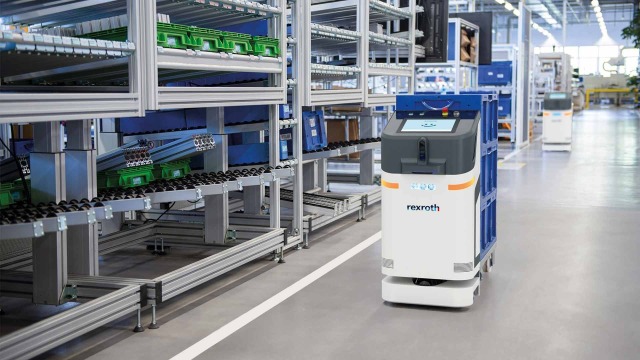Smart Factory: Revolutionizing the Manufacturing Industry
Modern technologies have changed the way companies in all industries do business. In the manufacturing industry, in particular, the introduction of the Smart Factory has led to a revolutionary change.
Definition of a Smart Factory
There are many definitions for the smart factory. Research envisions the factory of the future differently than The Production Management. And the latter defines it differently again than those responsible for automation . But what they all have in common in the definition: The smart factory responds flexibly to new customer needs, turbulence in supply chains, organizes itself and uses automation, networking (IIoT), modularization, robotics, as well as artificial intelligence in many applications. It demands software expertise from industry, is based on Industry 4.0 developments, and is thus also an important building block for energy-efficient production. At the same time, a smart factory is the answer to the shortage of workers in many production companies. The Smart Factory benefits from sensor technology, communication protocols, data, camera systems, MES systems and employee qualifications. Bringing people and technologies together and matching them with a business model is the challenge of the coming years.
Evolution of manufacturing
Traditional manufacturing methods
In the past, factories relied largely on manual labor. Workers performed repetitive tasks, resulting in high time consumption and low efficiency. Manufacturing of products relied heavily on human discretion and error rates.
Introduction of industrial automation
With the increase of industrial automation, machines were integrated into the production process to increase efficiency and reduce error rates. Computer control and robotics enabled the automation of tasks previously performed by humans.
Digitization and networking
The next evolutionary step in manufacturing is leading to the emergence of the smart factory with Industry 4.0. These state-of-the-art factories use advanced technologies to optimize and automate the production process. The Smart Factory relies on the concept of the Internet of Things (IoT) and enables communication and collaboration between machines, systems and people.
Key technologies in a smart factory
A Smart Factory combines several key technologies to ensure an optimized production process. The key technologies are:
Industrial Internet of Things (IIoT)
The Industrial Internet of Things (IIoT) enables the networking of machines, sensors and other devices in the factory. By collecting and analyzing real-time data, the smart factory can monitor asset health, predict maintenance needs, and detect bottlenecks. Combined with a high-capacity 5G campus network, communication between devices can be near real-time.

Artificial intelligence and machine learning
Artificial intelligence (AI) and machine learning (ML) play a critical role in the smart factory. Through the use of algorithms and advanced analytics, machines can recognize patterns, optimize processes, and perform predictive analytics. AI also enables machines to learn from experience and continuously improve.

Robotics and automation
Robots are central to the smart factory. They perform repetitive tasks, enable precise assembly, and work efficiently with other machines. By combining robotics and automation, a smart factory can speed up production and increase quality.

Big Data analysis
Big data processing and analysis is an essential component of a smart factory. By collecting data from multiple sources and analyzing it, factories can identify operational bottlenecks, address quality issues, and make accurate predictions.

Implementation challenges and considerations
Implementing a smart factory presents several challenges to companies and requires careful consideration:
Initial investment and infrastructure requirements.
Implementing a smart factory requires a significant initial investment in technology and infrastructure. Companies must invest in the necessary sensors, robots, machines, and data processing systems. In addition, a reliable network infrastructure is required to ensure smooth communication between devices.
Employee training and skills development.
With the introduction of a smart factory, work tasks also change. Companies must ensure that their employees have the knowledge and skills necessary to effectively use the new technologies. Training and education programs are critical to prepare the workforce for change and ensure they are able to make the most of the Smart Factory.
Data security and privacy concerns.
In a Smart Factory, large amounts of data are generated and processed. Protecting this data from unauthorized access and misuse is critical. Companies must implement robust security measures to ensure the integrity and confidentiality of data. Privacy regulations and compliance requirements must also be considered.
Future trends and forecasts
The evolution of the smart factory will continue in the future and offer new opportunities. Here are some trends and predictions:
Integration of Internet of Things (IoT) in the Smart Factory.
The integration of IoT technologies in the smart factory will continue to grow. By networking devices and machines, companies can gain a comprehensive overview of the entire production process and analyze data in real time. This enables even more precise control and optimization of factory processes.
Collaboration between humans and robots
Collaboration between humans and robots is becoming increasingly important. Collaborative robots, also known as cobots, work safely with human workers and complement their skills. This collaboration enables flexible and efficient production, where humans can use their creative and problem-solving skills while robots take over the repetitive work.
Use of predictive maintenance.
Predictive maintenance will play an important role in the future. By monitoring plant and machinery, the smart factory can detect potential failures and maintenance needs at an early stage. This enables planned maintenance and reduces downtime, resulting in higher availability and efficiency.
Conclusion
In summary, it can be seen that with the Smart Factory and its associated benefits, the manufacturing industry is being revolutionized. By using advanced technologies such as IoT, AI and robotics, companies can increase productivity, improve quality and reduce costs.
Our experts explain exactly how this works - the Smart Factory from the perspective of Bosch Rexroth, science and our customers.
Discover the Smart Factory for your company now with our tech podcast "Industry rethought".
Smart Factory Tech Podcast
FAQ Smart Factory
1. What is the difference between a traditional factory and a Smart Factory?
A traditional factory is mainly based on manual labor and has limited automation. A Smart Factory, on the other hand, uses advanced technologies such as IoT, AI and robotics to automate and optimize the production process.
2. How can a smart factory improve efficiency and productivity?
A Smart Factory can improve efficiency and productivity through the use of automation, robotics, and connectivity. Efficient and precise processes shorten production times and increase quantities.
3. Is a Smart Factory only suitable for high-volume production?
No, a Smart Factory can be implemented in companies of any size. The technologies and concepts can be adapted to a company's specific requirements and capacities.
4. What are potential risks and challenges in implementing a Smart Factory?
Potential risks and challenges in implementing a smart factory are the initial investment, training of employees, data protection and data security, and integration of existing systems.
5. How does a smart factory affect people's jobs?
With the introduction of a smart factory, work tasks may change. While repetitive and burdensome manual tasks are the main focus of automation, new, more skilled tasks in the areas of maintenance, monitoring and control of the smart factory open up for workers.
